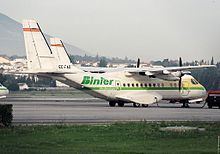Crew 3 Aircraft type CASA CN-235 Date 29 August 2001 Operator Binter Mediterraneo Survivor 43 | Passengers 44 Survivors 43 Registration EC-FBC Fatalities 4 Passenger count 44 | |
 | ||
Similar Loganair Flight 670A, 2001 Avjet Aspen crash, 2001 Omsk An‑70 crash, Thai Airways Internatio, Korean Air Flight 85 | ||
Binter Mediterráneo Flight 8261 (Registration EC-FBC), on 29 August 2001, crash-landed next to the N-340 highway, some 200 meters short of the runway 32 at Ruiz Picasso International Airport at Málaga, Spain. The captain reported to Málaga Air Traffic Control, while on final approach, a fire in the aircraft's port engine. The fire turned out to be a false alarm but, in following the emergency procedures, the First Officer inadvertently shut down both of the aircraft's engines. The plane descended, hitting the airport approach lights, and stopping next to the N-340.
Contents
Four out of the 44 people on board were killed, including the captain. The aircraft was scrapped.
Take-off and flight
Binter Mediterráneo Flight 8261 took off the at Melilla Airport at 09:37 CEST on 29 August 2001, with 47 people on board (44 passengers and 3 crew). The weather was fine.
Attempted landing
During the approach to runway 32 at Málaga, a warning light in the cockpit indicated a fire in the port engine. In fact, it was a false alarm, possibly caused by moisture and/or dirt in the circuitry, though the crew did not know this. The captain continued the approach, while the co-pilot followed the emergency procedure for an engine fire. In the process, he erroneously activated the fire-handles for the right engine as well as the left, causing them both to stop. The plane landed some 500m short of the runway threshold and came to rest against the embankment of the N-340 motorway. The pilot did not report anything to the PA.
Three passengers plus the pilot were killed in the accident.
Causes
While the co-pilot's incorrect execution of the emergency procedure was the primary cause of the accident, the investigators learnt that he had not received any simulator training in emergency procedures from the airline.
The investigation also considered that incomplete adherence to relevant maintenance procedures was the most likely reason for the false fire alarm.
Remains of plane
The remains of the plane were taken to the CASA Sevilla factory, for an investigation. Following completion of the investigation, the aircraft was scrapped. The tail was saved however, and is exhibited in the Museo del Transporte Aéreo de Málaga.
